Willow tree bark tincture is a pain reliever that’s easy to make. As the main ingredient found in aspirin, the inner pith of willow bark is nature’s great analgesic.
Knowing which products in our own backyards can relieve pain serves a survivalist well. What if, instead of “taking two aspirin and calling the doctor in the morning”, we just carved a chunk of bark from a willow tree, and made a tincture?
Although tinctures need four weeks to cure, any home herbalist will tell you how deeply satisfying it is to create natural medicine that works as good as (or better than) store-bought varieties.
History Of Willow Bark As A Pain Reliever
Willow bark was the original aspirin. The first recorded use of willow tree bark was found on Sumerian clay tablets dated around 4000 B.C.
Pain, inflammation, and fever reduction were the top three purposes for using willow bark. Salicylic acid is the derivative that performs the pain-relieving action prescribed by aspirin. In fact, the Latin word for willow is actually salicin.
Hippocrates, the Greek father of medicine prescribed willow bark as an analgesic around 400 B.C. He recommended that people suffering from common ailments such as headaches, fevers, and inflammation chew the tree bark as a remedy.
By that same token, Hippocrates also prescribed a strong tea from willow bark to lessen the pain of childbirth.
How Willow Bark Became Aspirin
The Bayer Company first introduced aspirin in 1899. Aspirin was the first semi-synthetic drug ever produced.
Due to the fact that willow bark created stomach aches in some people, scientists isolated the salicin from the rest of the plant. This method created a chemicalized form, known as a modern drug.
The irony here is that some people cannot tolerate aspirin because it causes a tummy ache. But, they can tolerate willow in its base form.
By isolating one ingredient from the rest found in willow bark, side effects that were preventable by using the whole plant were introduced. Perhaps the truth lies in the fact that aspirin or willow bark should not be taken on an empty stomach.
Whatever the case may be, aspirin continues to be the top-selling pain reliever in the world.
Related: How To Make Aspirin From Willow Bark
Pain-Relieving Willow Bark Tincture
Tinctures are incredibly simple. First, gather an herb and dry it out as best you can. Harvesting plants in the great outdoors is super easy, and they don’t have to necessarily grow on your own property. Luckily, willow grows everywhere except for Australia and Antarctica.
The easiest way to get willow from someone else is to use social media, which when used for this purpose redeems itself. Neighbors love to help one another achieve simple goals, and the best way you can get access to naturally existing products is to simply ask.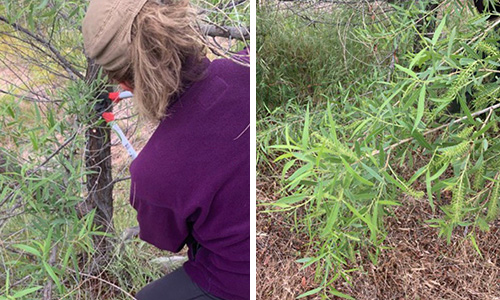
Once you’ve realized where your willow grows, just cut some young branches and literally whittle out the tender pith in the middle.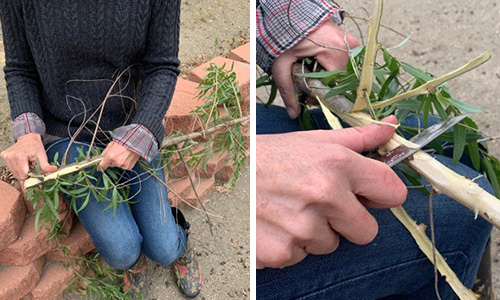 You’ll need enough bark to fill your jar halfway to ⅔ full. I cut out about three young branches from my neighbor’s property.
You’ll need enough bark to fill your jar halfway to ⅔ full. I cut out about three young branches from my neighbor’s property.
No need to attack the tree trunk, as the best stuff actually comes from the youngest areas, the easy to get to branches.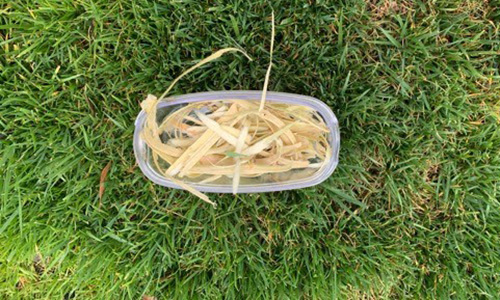 Now spread your new carvings on a paper towel and let it dry out for a day or two. The more dry your herb is, the more potent your tincture will be.
Now spread your new carvings on a paper towel and let it dry out for a day or two. The more dry your herb is, the more potent your tincture will be.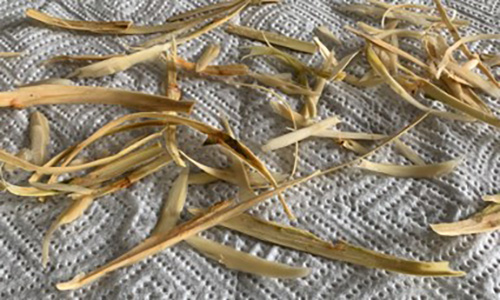 Related: 25 Little Known Survival Uses For Tree Bark
Related: 25 Little Known Survival Uses For Tree Bark
Required Supplies
- 4 or 8 ounce mason jar
- 40% alcohol vodka (80 proof)
- Small brown glass bottle with glass dropper
Choose The Right Alcohol For Your Pain Reliever
In a 1:4 ratio, (one part herb to four parts alcohol), pour the alcohol over the herb in a glass jar. I love using small mason jars for these projects. Just make sure the product doesn’t touch the lid, as the metal can cause an unwanted chemical reaction in your tincture.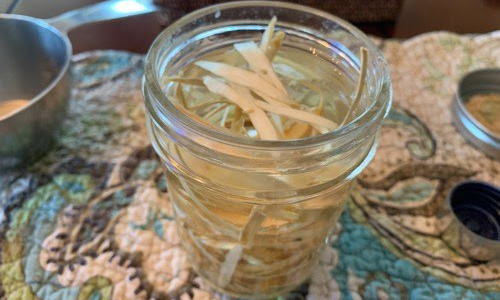 For this project, I went with 80 proof Vodka, which is 40 percent alcohol. If you were to make a tincture using a floral herb such as echinacea, you’d want to go with higher-proof alcohol. This is because flowers are more soluble in alcohol, so getting the strength of medicine to efficacy will require a more potent alcohol.
For this project, I went with 80 proof Vodka, which is 40 percent alcohol. If you were to make a tincture using a floral herb such as echinacea, you’d want to go with higher-proof alcohol. This is because flowers are more soluble in alcohol, so getting the strength of medicine to efficacy will require a more potent alcohol.
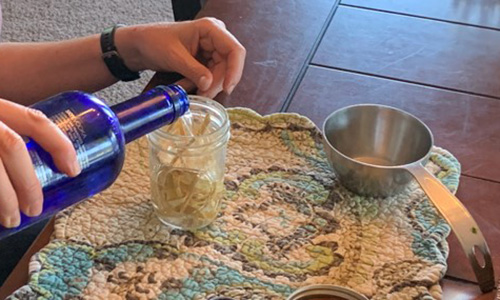 Luckily, willow is more water-soluble, thereby making lower-proof alcohol an easy choice. If for some reason you go with higher proof alcohol, then let the product stand for less time than is prescribed or simply dilute with water.
Luckily, willow is more water-soluble, thereby making lower-proof alcohol an easy choice. If for some reason you go with higher proof alcohol, then let the product stand for less time than is prescribed or simply dilute with water.
Willow tincture needs to stand for three to six weeks before you separate the herb from the alcohol and return the herb to the earth. Squeeze the willow to get as much potency as possible before discarding.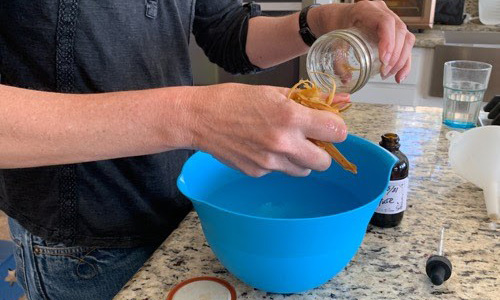 Also, store in a dark cabinet for three to four weeks, ensuring the bark is fully submerged in the vodka.
Also, store in a dark cabinet for three to four weeks, ensuring the bark is fully submerged in the vodka. Now you need to pour the remaining alcohol/mixture into a small brown glass bottle with a glass (not plastic) dropper. Just like the metal lid on the bell jar, plastic will also react unfavorably with an herbal remedy.
Now you need to pour the remaining alcohol/mixture into a small brown glass bottle with a glass (not plastic) dropper. Just like the metal lid on the bell jar, plastic will also react unfavorably with an herbal remedy.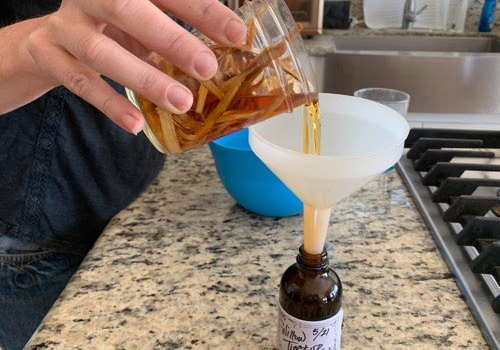 Make sure to label and date the tincture. Once you get started making herbal remedies, you won’t want a bunch of non-labeled bottles cluttering the medicine cabinet.
Make sure to label and date the tincture. Once you get started making herbal remedies, you won’t want a bunch of non-labeled bottles cluttering the medicine cabinet.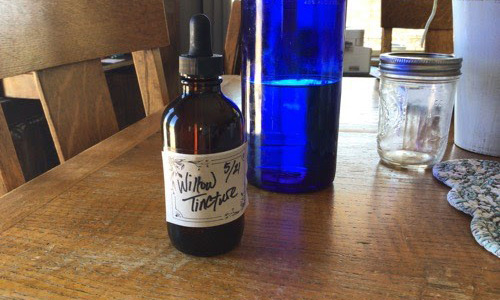
If alcohol is a no-go in your home, then you may alternatively use apple cider vinegar. Allow for six weeks’ rest in order to have a strong result. Then separate the bark from the vinegar and continue with the method.
Related: Making Raw Apple Cider Vinegar at Home
How And When To Use Willow Tincture
Since this tincture is strong, begin with taking a few drops on your tongue. You can always add more if this isn’t enough.
To use a tincture, fill the dropper with the liquid and drip it into the mouth, just under the tongue. Hold the tincture in your mouth for a few seconds before swallowing. Rinse your mouth thoroughly with water to get rid of the bitter taste.
It’s amazing how a very bad-tasting herbal can taste just fine for someone in need of relief.
Since time immemorial, natural products have been relied upon as the backbone of traditional healing systems. Knowing how to process medicinals that grow in your area is an amazing skill.
As with all new things, a bit of practice here helps. Because of that, we encourage you to try your hand at home remedies on your homestead regularly. When your bottle of aspirin runs out, try taking willow!
You may also like:
 5 Medicinal Plants that My Grandmother Grew in Her Backyard
5 Medicinal Plants that My Grandmother Grew in Her Backyard
The Only 4 Antibiotics You’ll Need When SHTF (Video)
How to Create a Vehicle Emergency Kit

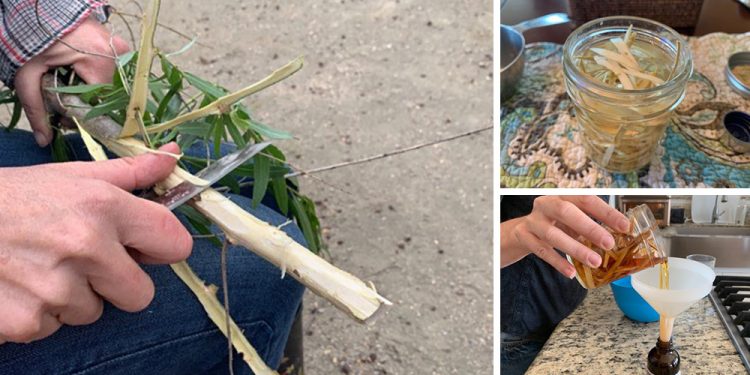













I am confused. Are you using the inside (pith) or the bark?
My dad always made willow tea. So did I during my time living in the woods. We also made willow whistles from branches around 1/2″. I don’t have willows here. I take cottonwood baby leaf buds in spring and cover them with 2 parts glycerine and
1 part water for a few weeks. It’s a great painfighting massage oil when I add an equal part sweet oil to it. Or the glycerine and water – 1
teaspoon in a 6 oz teacup of boiling water.
The willow is stronger than cottonwood but it still will help with pain.
Have you tried planting NM willow trees? Natives are supposed to be hardy up to Zone 4. http://osunanursery.com/new-mexico-friendly-trees/
I have always read it’s the inner bark that is right up against the wood which is scraped off and used but I have no personal experience.
Does it matter which kind of willow tree, there are so many.
According to TONY Q’s October 16, 2020 post, https://www.askaprepper.com/how-to-make-aspirin-from-willow-bark/
“With over 300 species, the good news is that all willows contain some amount of salicin, but the strength varies. It is claimed by some that White Willows are stronger medicinally, but I do a simple taste test of the bark- the more bitter (like an aspirin tablet) the better, I find.”
White willow is a European willow that was once popular as a landscape tree here, but I haven’t seen one in years. Native willows are common near water, dozens of varieties and all suitable for use. Cottonwood and aspen are also good sources of salicin, aspen of course growing in the Western mts away from water.
The method in the article will work but it is a waste of time and vodka since salicin is water soluble. 80 proof vodka is 60% water, it is the water in the vodka that removes the salicin from the bark. Soaking for weeks in vodka you are not making a tincture but a cold infusion, you get the same results soaking the bark in water for a month. The best way to utilize these barks for salicin is to chop it finely, put it in a tea ball, boil a pot of water and pour the water into a cup then drop in the tea ball and let it steep for ten minutes or until you get a dark red color to the liquid. Of course the violent American way to make tea is to put it in a pot and boil it 10 minutes, which also works. It is necessary to consult a herbal manual or a good herbalist before preparing plant material, some compounds are water soluble, some soluble in alcohol and others in oil, some need heat, some don’t.
This is a good article on stuff you can do with willow bark.
https://www.foragingtexas.com/2008/08/willow.html
It’s the wonder drug in its most natural form! I’m wondering if you don’t have the time or materials or are in a position to make a proper tincture, but need the remedy for immediate relief, if one could suck or chew on the willow shavings themselves in an emergency as a last ditch effort. Anybody know?
CC: Chew a twig and see. People used it to clean their teeth that way. then, burned, chewed on the charcoal, as well, to absorb acids in the mouth. The teeth turn gray, but it prevents cavities. niio
My dad always made willow tea. So did I during my time living in the woods. We also made willow whistles from branches around 1/2″. I don’t have willows here. I take cottonwood baby leaf buds in spring and cover them with 2 parts glycerine and
1 part water for a few weeks. It’s a great painfighting massage oil when I add an equal part sweet oil to it. Or the glycerine and water – 1
teaspoon in a 6 oz teacup of boiling water.
The willow is stronger than cottonwood but it still will help with pain.
We got plenty of cinnamon and camphor trees down here.
That massage oil is a great recipe, thanks! As you say, making tea is the proper way to use willow, fast and easy. By sweet oil do you mean olive oil? Going to make a batch of cottonwood massage oil this spring, big cottonwoods right down the hill from me.
Considering they’ll be by a water source typically, personally I’d check the water the tree was drinking. I would steer away from a willow say next to an irrigation ditch in an industrial part of town if at all possible, but maybe that’s just me.
Non the less great article, saved a pdf and will probably print later. Thank you.
Willows have been studied extensively for scrubbing heavy metals from soil and water, and are very good at it. Probably a good idea to steer clear of willows growing near pollution sources.
Just to clarify – willows grow very well in Australia but other than maybe 3 horticultural varieties, they are considered noxious weeds to be eradicated. I’ve been trying to source a basket willow for cane work but can’t find any and not allowed to import it, so I’m using what I can. I have Golden Weeping and S.babylonica growing which I will try to use as described above in the near future. Also planted some hybrid poplars this winter. They all have spring growth now and looking good so hopefully they survive the summer season.
S. babylonica has long flexible canes, it should be great for baskets. Pretty tree, but thirsty.
Thanks Judge, I thought they looked suitable too. Got it planted on a creek bank near a soak so hoping it survives ok.
I am alergic to aspirin. (not to a severe degree’ just don’t get all the air I should), I wonder if this tincture would have the same effect or be without the breathing problem? Of course I would take only a minute amount to see.
Mary: All I can say is, do a skin test. Ask the doctor about it first. niio
Birch and poplar trees contain salicylic acid so if you can’t find willow but see birch or poplar, you can use those.
mbl – Knowing alternative sources are out there, well this is what I would call vital information! Many of the birch trees in our area have been destroyed by the birch borer. i tried to save mine, but lost both trees to the disease. I always hoped they would reach a size were in I could try to tap them for syrup, but that was not possible once the disease set in. The alternative tree that is now being planted here is the River Birch. It is said to be resistant to the disease.
CC: Best birch to tap is black birch. they used to ferment the sap for birch beer. Roots were used to flavor another kind of beer. White birch is bitter, if memory serves. stay safe. niio
I am simply going to re-use a comment I posted on another web site about this issue. I strongly suspect that all of the endorsements of the idea’s usefulness are based on the placebo effect, but what do I know?
Here’s my comment”
I have no training in medicine or pharmaceutical matters (but I did stay in a Holiday Inn Express last night). I have read numerous survival site articles about the use of salicylic acid for pain, but I did not have the necessary knowledge to determine whether the articles gave useful advice or not.
All I can tell you is that in the BBC-produced series, “Pain, Pus, & Poison,” the development of aspirin, among many other things, is discussed. In it, it is mentioned that salicylic acid that was produced from coal tar brought down fevers, but it had no effect on pain.
Dr. Walter Sneader, former head of the School of Pharmacy of the University of Strathclyde, said that he keeps hearing about the use of salicylic acid in ancient times. He concedes that ancient people may have used salicylic acid as pain killers but, he says, “[T]hey didn’t work.” Put simply, without salicylic acid’s combination with another compound (please excuse me, but I can’t understand the word he used because of 1) my lack of pharmacological training, and, 2) his British accent), simple salicylic acid has no effect on pain.
Once German scientists figured out how to synthesize the new compound christened “Aspirin” they were off to the races and Bayer made it the world’s No. 1 best-selling pain killer.
My advice is to stock up on aspirin. It is cheap and plentiful everywhere now, and no serious prepper’s medicine cabinet should be without it.
How long is it good for?